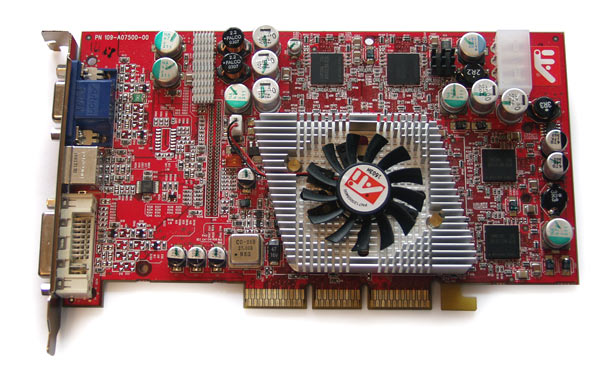A Roundup of ATI Radeon 9800 PRO video cards
ATI Radeon 9800PRO 128MB (reference)

ATI Radeon 9800PRO 128MB (reference) *1200x757 221 kb
| ATI Radeon 9800 PRO 128MB Reference Board |
| GPU |
ATI RADEON 9800 PRO |
| Memory (Max) |
128 MB DDR SDRAM 2.8 ns |
| Memory/processor clock speed |
380/340(680) MHz |
| RAMDAC Frequency |
400 MHz |
| API |
OpenGL, DirectX, Direct3D |
| Support for two monitors |
Yes |
| Video Output |
2048 x 1536 / 60 Hz - 24-bit (16.7M colors) |
| Interface |
AGP 8X |
| Ports and connector type |
1 x DVI-Analogue Digital - 29 pin DVI
1 x VGA - 15 pin HD D-Sub (HD-15)
1 x S-video output |
| Maximum resolution |
2048x1536 / 60 Hz |
The video card and package bundle
This regular reference card of ATI is made on a red PCB which is already standard for ATI boards. What catches the eye first is the cooler. This design merits a special mention.
The cooler is made fully of aluminum, of parallelepiped shape, which already makes one wonder. The cooler radiator is cut into rather thin horizontal fins sawn vertically in the very center of the radiator where the fan is fit, which makes up sort of a square over the center and a needle-shaped radiator in that place. At the cooler base, under the fins of the fan there are four oblong holes - on top, below and on the sides. Due to these holes, the air flows hit the chip substrate and produce additional cooling. A most simple and well thought out solution for improving the cooling efficiency - a good bargain, isn't it?
Over the middle of the radiator's bottom surface there is a projection running through the whole radiator's length, well-polished at the joint with the chip. Therefore, the radiator is tightly fixed to the chip, and the protective frame causes no cooling issues any more, the way it used to be on some Radeon 9700 PRO specimen.
The noise level of the new cooler proved to be quite low, even lower than in the predecessor model, Radeon 9700 PRO.
The new cooler turned out to be well thought out, efficient and quiet; the loud-voiced FX Flow monster and other coolers for GeForce FX are simply beyond any comparison.
That silver thermo conductive paste Arctic Silver is used as the thermal interface between the cooler and the chip really good.
I was amazed by the fact that the same memory modules (Samsung 2,8 ns marked as K4D26323RA-GC2A) similar to those on the Radeon 9700 PRO are installed. This partly proves my assumption on the understated memory power supply voltage on the Radeon 9700 PRO which I had while testing the board. There are 8 memory modules as before, and what's surprising they are not cooled as before albeit heat up more intensely.
ATI seems to be reluctant about equipping the memory chips with radiators - that could have been of great use to the stability, and such solution isn't so costly. Well, ATI is huge and the company knows it better :).
Of course, additional power supply was used, and the onboard power connector is bit more handy than that on Radeon 9700 PRO - instead of the small four-pin Floppy connector there is a regular Molex, the way it is on the HDD or CD-ROM drive.
While breaking the fragile connector pins used to be easy, now you may forget about it.
Since that is an ATI's reference board, you can't expect advanced package bundle. So, the board comes bundled with the following items:
- Additional power cable
- DVI -> D-Sub adapter
- S-Video->RCA adapter
- S-Video extension cord
- RCA extension cord
- Drivers CD (ATI Catalyst 3.4)
In fact, you can't expect much from a reference board.
Overclocking and impressions
The card started up and was running stably at 450/750 MHz! The result is great, especially for the 0.15 mk process technology of the chip and the complete lack of cooling on the memory chips. The superb overclocking potentials of the chip points to one good thing - at ATI, the 0.15 mk process technology has been tuned to perfection and offers some margin for frequencies, which allows ATI to produce some more chips following the 0.15 mk process technology prior to migrating the higher-end chips to a new process technology.
The card produced a fantastic impression - the manufacturing quality and performance are up to the mark, and the overclocking potentials will certainly appeal to even the most exigent overclocker.
 |
Content: |
 |
|
 |
Top Stories: |
 |
 |
 |
MoBo:


|
 |
 |
 |
VGA Card:


|
 |
 |
 |
CPU & Memory:

|
|
|
